All you need to know about your products!

| 3DNews Vendor Reference English Resource - All you need to know about your products! |
||||||
 |
||||||
|
|
||||||
Dual-core Pentium D 805 (Smithfield)Author:Date: 15/05/2006 IntroductionLate last year, a critical situation shaped up on the market of desktop processors. Because of missed supplies of AMD's lower-end processors, prices on them went up immensely, almost twice as much. That resulted in the rise of prices for Intel processors, albeit not that high. But in March this year prices for Athlon 64 3000+ and 3200+ stabilized and now they can be made available at 3200 rubles (~$115) and 3600 rubles (~$130), respectively. Prices for Intel processors remained unchanged: the 6х0 line still sells at quite a high amount, P4 630 - at 4700 rubles (~$160), P4 640 - at 5600 rubles (~$200). As a result, if contra-posed, the produce by AMD offers substantial price advantages, lower heat emission level, and higher performance at games. Absolutely reverse situation shaped up on the market of desktop dual-core processors. As before, Athlon64 X2 3800+ is still AMD's younger model which is available at 9000 rubles (~$320), whereas Intel offers Pentium4 920/930 at quite affordable 6600/6800 rubles ($235/$240). The Pentium 9x0 line is based on the new Presler core which features in a relatively new level of heat emission and superb overclocking capability. The low price is definitely not enough for a convincing victory, but at least it can make the user think twice before making a purchasing decision. According to Intel's plans for aggressive promotion of dual-core processors, for the recent months the company has released a very interesting model - Pentium D 805. It is based on the Smithfield core (1 MB of L2 cache per each core), runs at 2.66 MHz, and the system bus speed is 133 MHz (533 MHz QPB). This processor did not arouse much interest but only until it hit the retail at 3700 rubles (~$125) for the OEM version (versus 4000 rubles (~$135) in the BOX version). As a result, the processor simply has no direct competitors and we can state that it has created a new market of dual-core low-end systems. Pentium D 805 processorThe processor is packaged in a box of the following form: 
The user can get a complete information on the processor from both the box cover 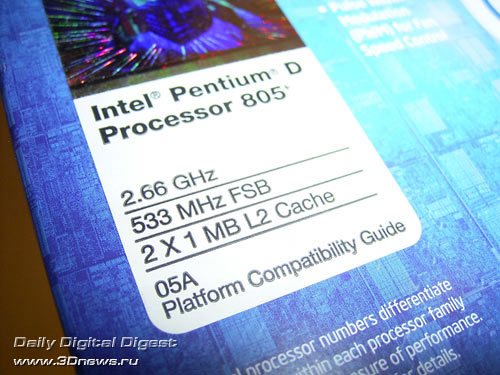
and the marking of the processor which is seen through a transparent window in the upper part of the box. 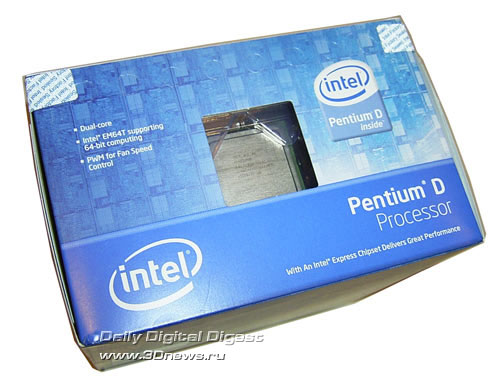 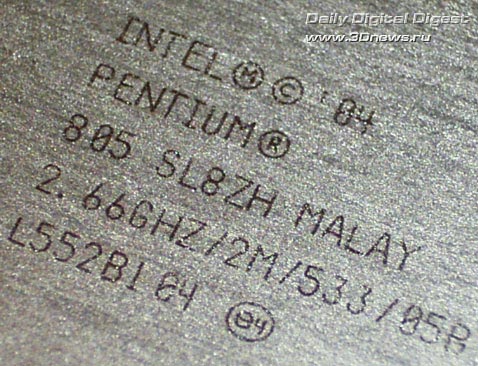
Externally, the processor doesn't make any difference from other LGA775 models. 
On the reverse side, Pentium D 805 has the same positioning of capacitors as in the processors of pervious steppings of the Smithfield core: 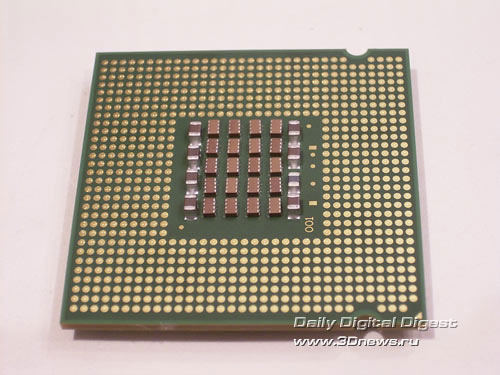
As you can see, the processor in question is based on a new stepping of the Smithfield core - F47 B0 (remember that the first Smithfield processors were based on the stepping F44 A0). 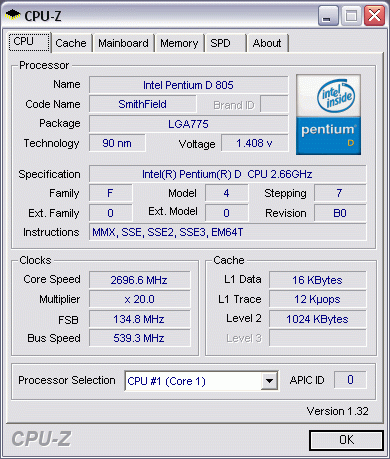
Therefore, we can expect some improvements in power consumption and overclocking. In fact, it's just overclocking we are most interested in since the lower-end models of processors show the best results at that and allow for improving the system performance substantially, and to save some money on that. Heat emission and overclockingLet's start with the heat emission. The new stepping, albeit has reduced this part but insignificantly, so we didn't any substantial difference as compared to the previous Smithfield. The two cores are as hot as braziers in hell, so to harness this "oven", the user would have to buy quite an expensive cooler. If we restrict to a boxed cooler, then we get quite a noisy system. 
The only advantage of a boxed cooler is the copper insert in the base and quite a convenient installation procedure. 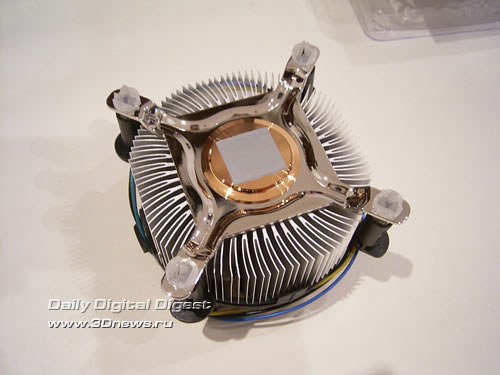
Now let's talk about the overclocking capability. Let's start with the most important: as some inquisitive readers have noticed, the multiplier of Pentium D 805 equals 20. Therefore, the high multiplier suggests the ease of overclocking. For instance, as the FSB speed is raised by 5 MHz, the processor's clock speed goes up by as high as 100 MHz. Such a high value of the nominal multiplier is directly related to the low frequency of the system bus, which equals 133 MHz (533 MHz QPB). Therefore, in overclocking the FSB from 133 MHz to 200 MHz, all the system components run in the nominal mode (modern motherboard can fix values of the PCI, PCI Express buses, and SATA). It turns out that even with the most cheap motherboard with the feature for adjusting the FSB within this range we can squeeze out the most of any Pentium D 805. Upon attaining the maximum, the user gets a performance comparable to Intel's top-end desktop processors. We also note that the multiplier in Pentium D 805 is fixed and can't be changed even towards the reduction. Unfortunately, this fact will not allow setting the bus to 266 MHz (1066 MHz QPB) and thus turning the "ugly duckling" into an Extreme Edition costing as high as 800 - 1000$. There is one point, though: the BIOS of the motherboard must detect the new processor. For example, with ABIT AS8 (i865PE) the system wouldn't start and re-booted upon the video initialization. It's now time we moved on straight to the overclocking. We used ASUS P5WD2 Premium and easily attained a stable system operation at 195 MHz. In the end, the test processor was able running at 3.9 GHz (almost a 50% performance boost)! 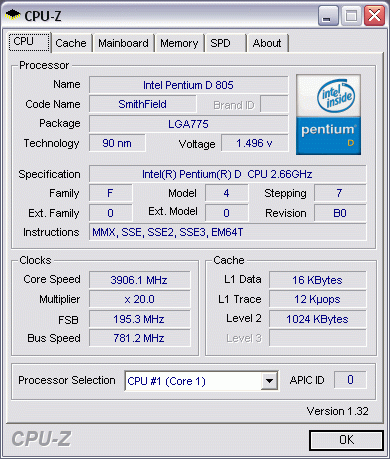
Actually, the system did start up at 4.0 GHz either, which shows that successful specimens of 805 processors may overcome the barrier provided there is matching cooling. We stress it out once again that the new stepping Smithfield B0 has seriously increased the overclocking capability from 3.2-3.4 GHz (of stepping A0) to 4.0 GHz! PerformanceWe now move on to the most interesting part of the review which is devoted to the performance of Pentium D 805. So, to compare the operating speed, we used the results of all the previous processors, both single-core and dual-core.
We used a customary set of application benchmarks. Let's first take a look at the results of synthetic benchmarks. 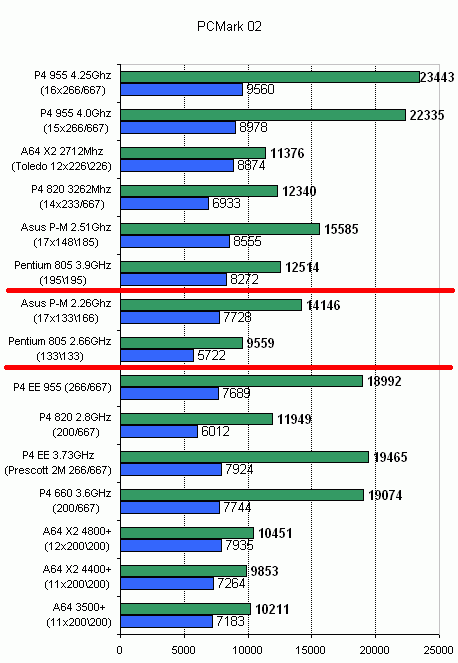
These are exclusively synthetic benchmarks which demonstrate the theoretical performance. Now on to the gaming benchmarks. 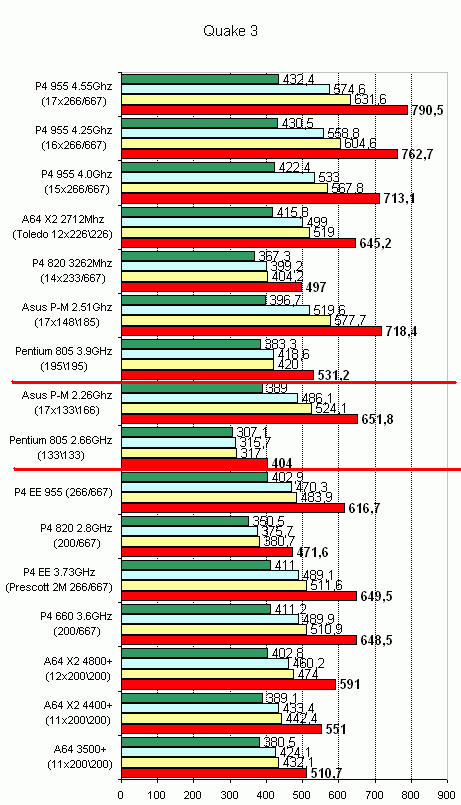
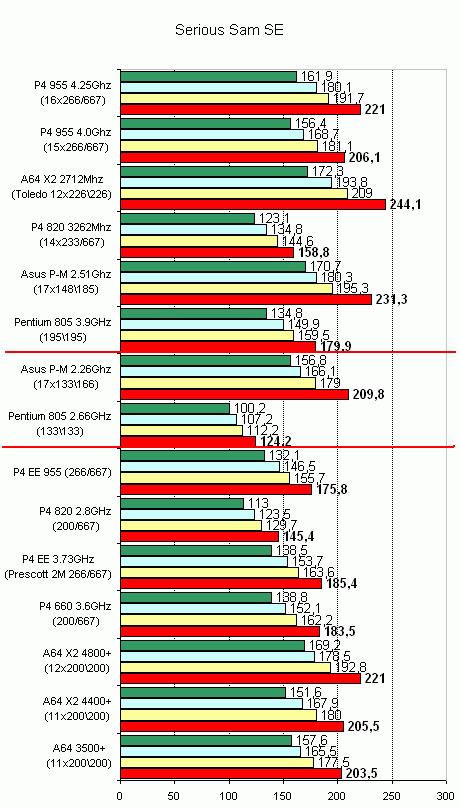
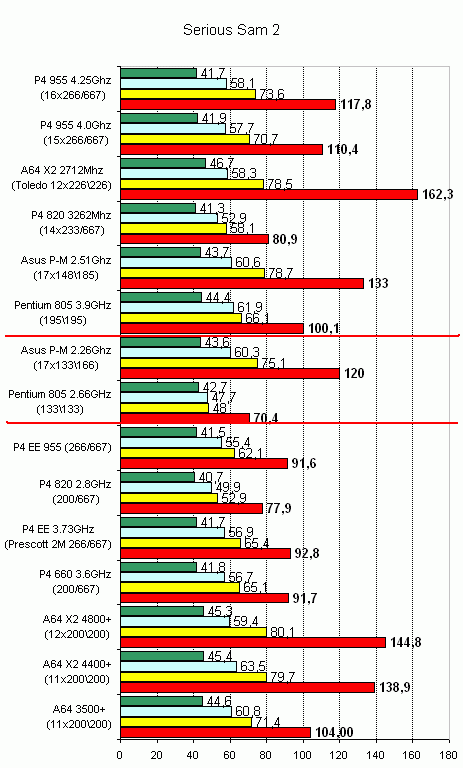
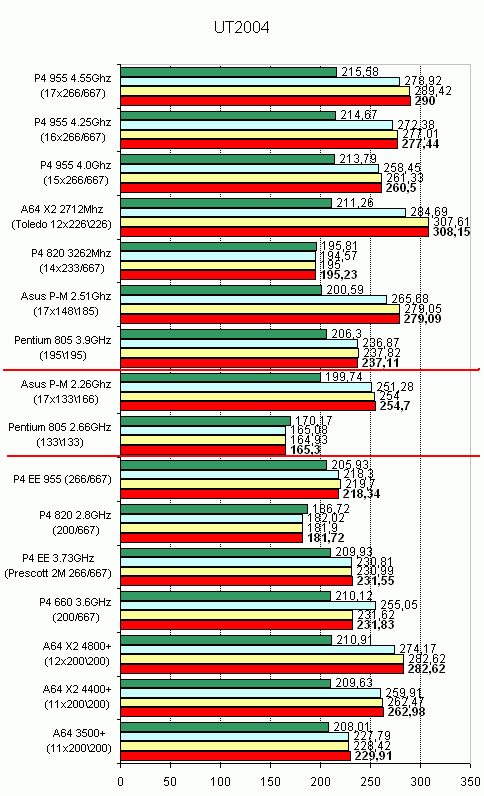
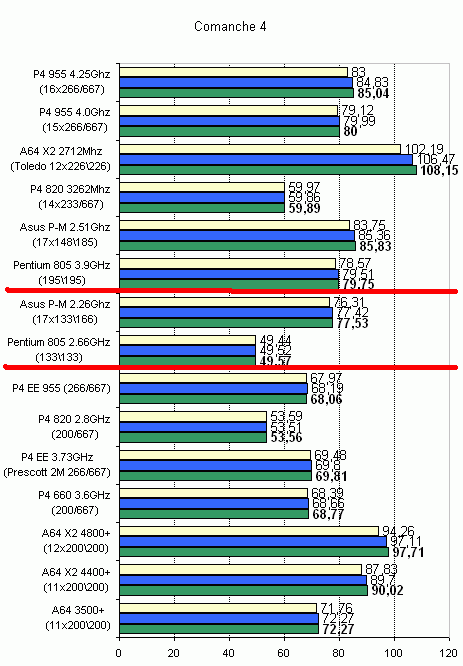
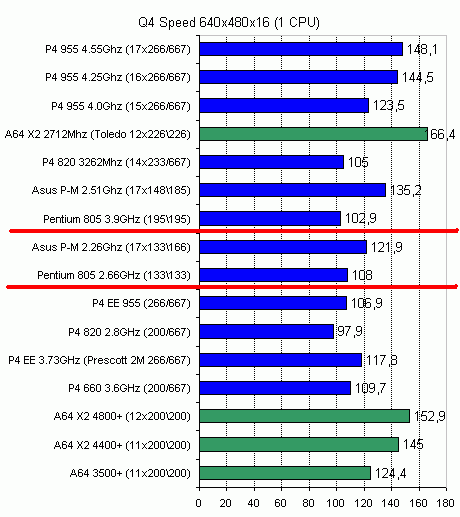
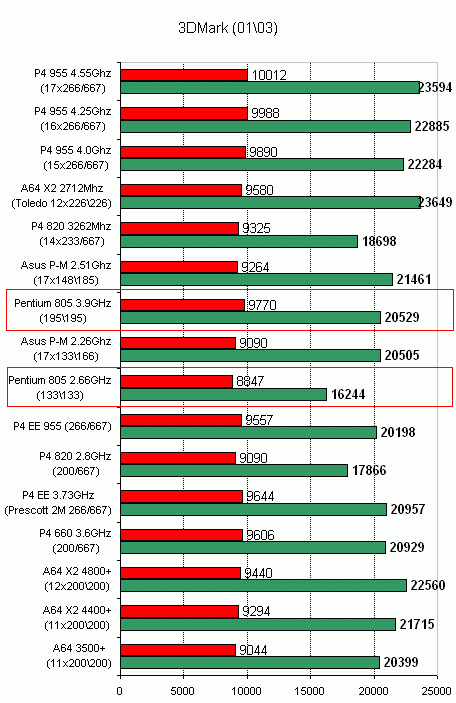
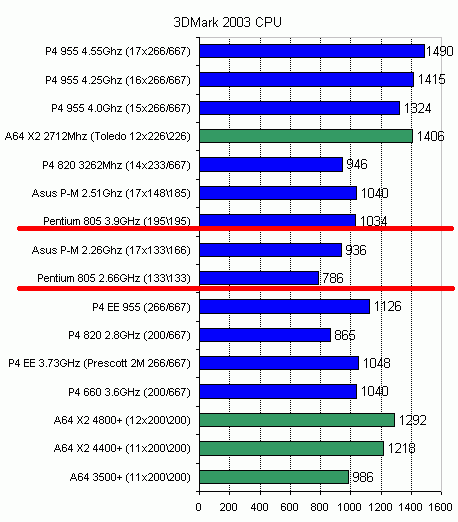
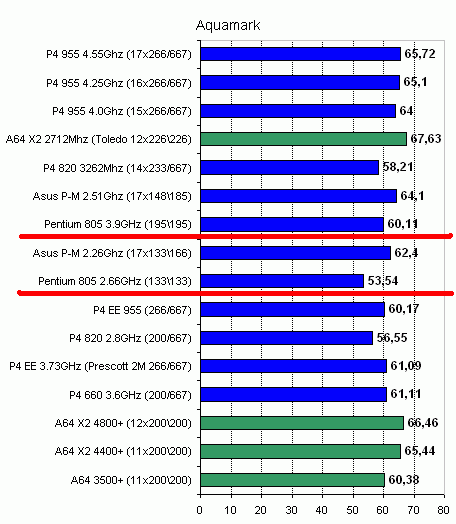
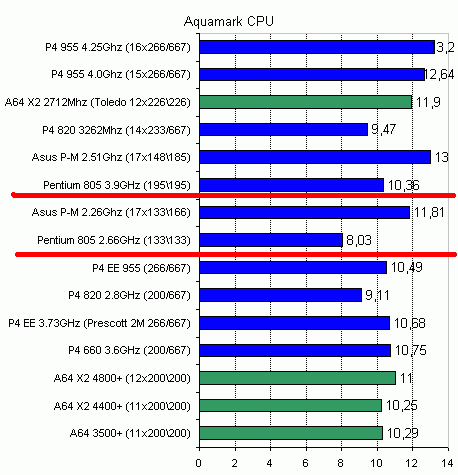
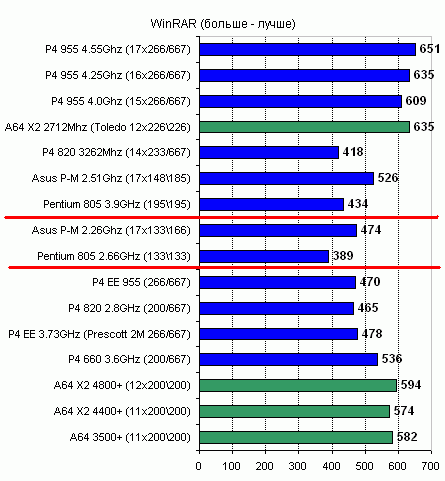 Kb/s, the more - the better 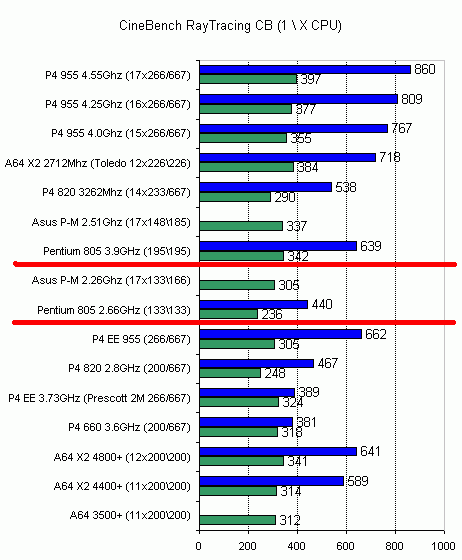
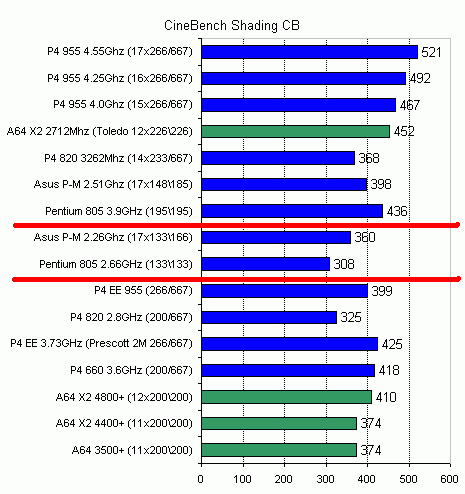
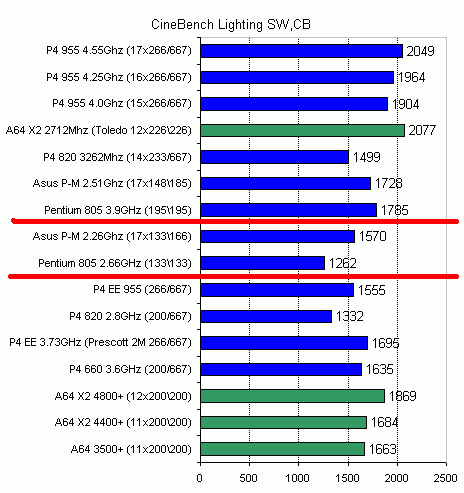
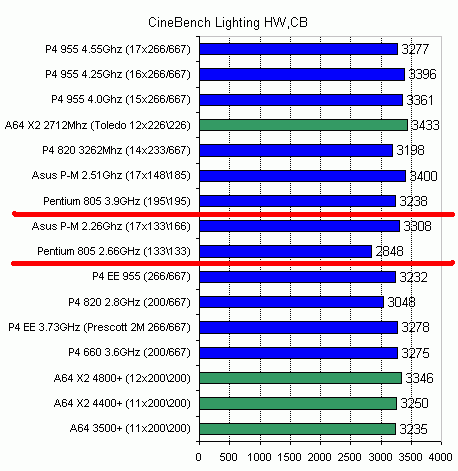
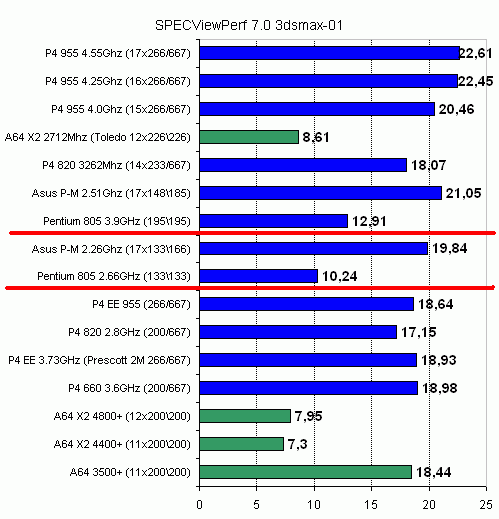
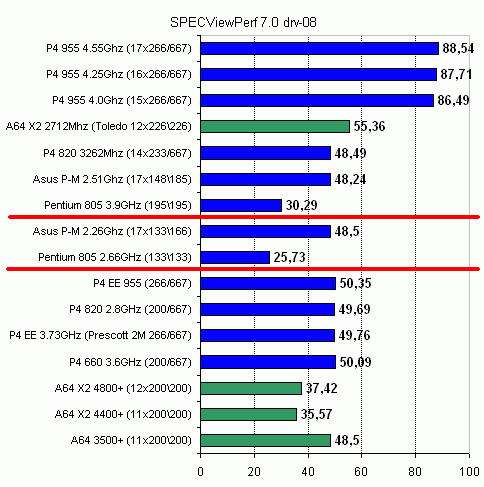
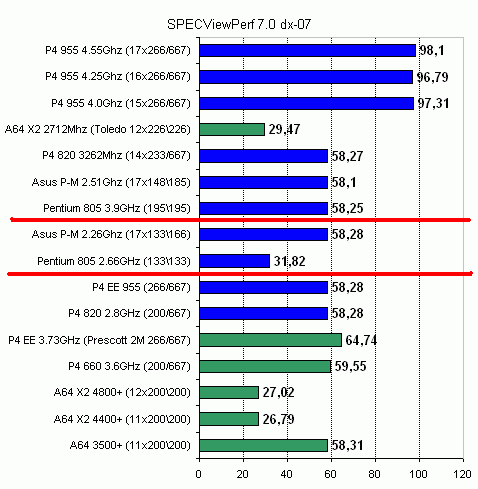
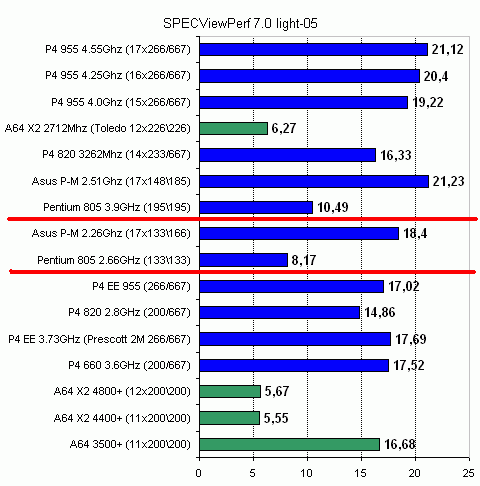
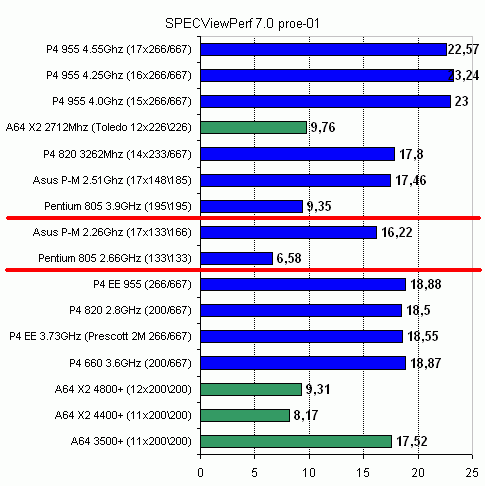
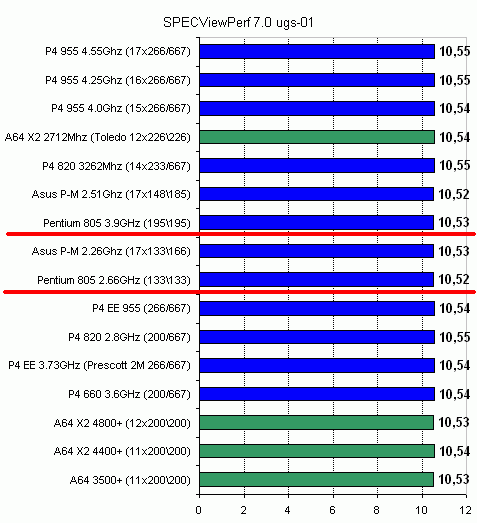
Final WordsFirst, Pentium D 805 at the nominal clock speed 2.66 GHz expectedly loses to model 820 due to the lower clock speed and lower FSB speed. On the other hand, the lag is not critical, and model 820 costs about $35 more (which is higher than 25%). The situation radically changes on overclocking the 805 processor to ~4 GHz. In fact, at 3700 rubles ($130) we get almost the fastest Intel's dual-core processor, which is second at speed to merely Extreme Edition which costs 1000 $. Moreover, the version Extreme Edition 955 is faster only in those applications where the L2 cache matters (e.g., Quake3/Quake4), and in other gaming applications the higher clock speed beats the modern architecture of the Presler core (Serious Sam, Serious Sam2, Comanche, and UT2004). However, all modern games do not make use of the advantages of dual-core processors. Even Quake4 demonstrates inadequate results upon enabling the multiprocessor mode. On the other hand, when overclocked to 4.0 GHz, the processor 805 will show its best in a lot of applications to handle stream data, as well as in rendering tasks etc. But in this case the dependence of mentioned applications on the L2 cache size should be taken into account when choosing a processor. If there is such a dependence, the user's choice falls on a Presler core processor. And one more, perhaps the most important conclusion. In view of the overclocking capability of Pentium D 805, this processor is more attractive for its much lower price than any single-core processors of series 6х0! And this situation will stay until the autumn of 2006 when Conroe processors appear on sales. The performance of the latter will essentially exceed the speed of all the existing Intel's desktop processors. It can be approximately rated using the available graphs (look at the results for Pentium-M), and the scarce information on the overclocking capability promises clock speeds as high as 3 GHz. P.S. Join the conference with all your questions, remarks and suggestions. The test processor Intel Pentium D 805 was presented by Sunrise-Rostov. |
|
|||||